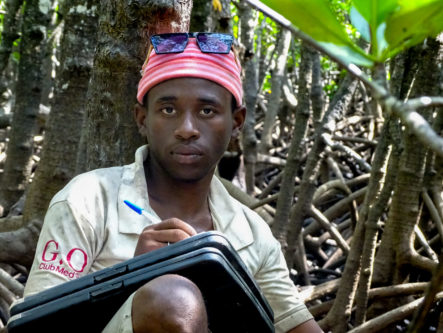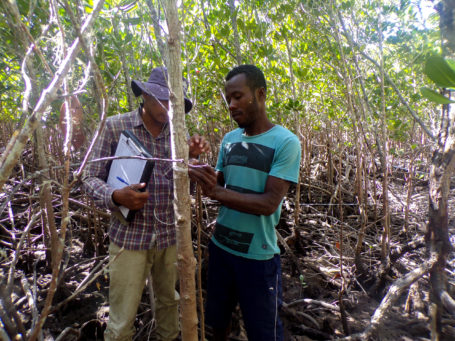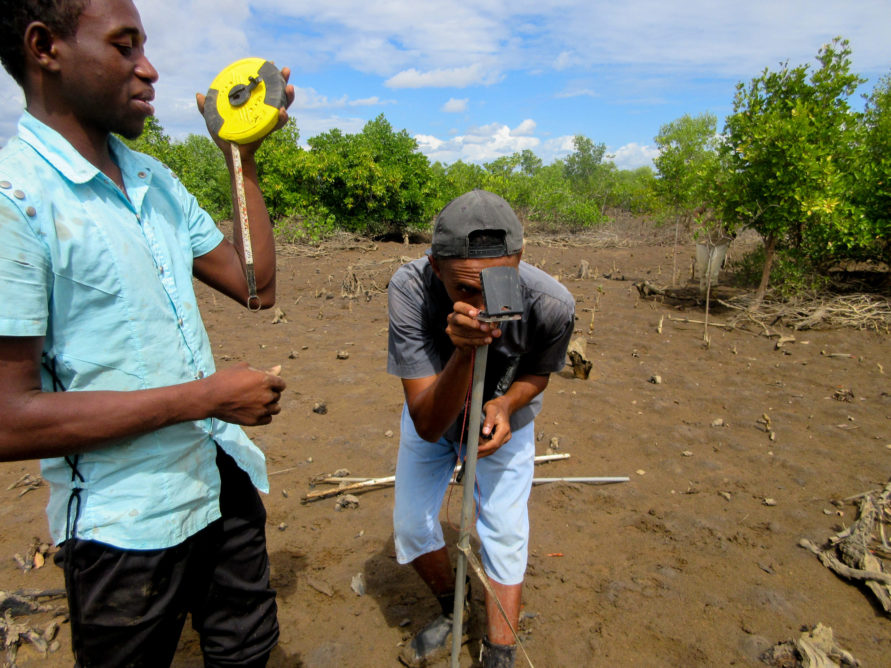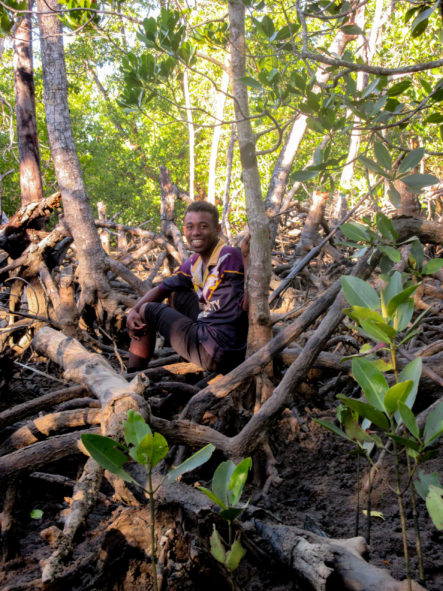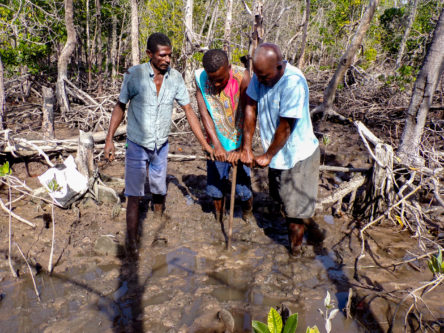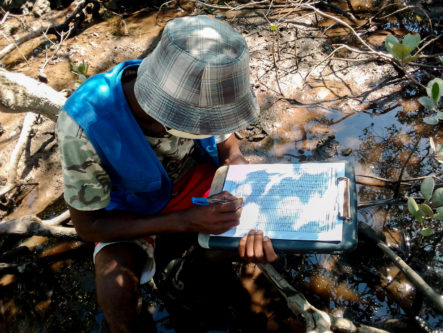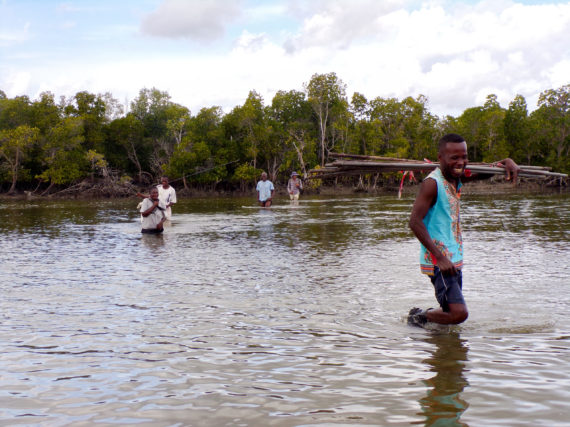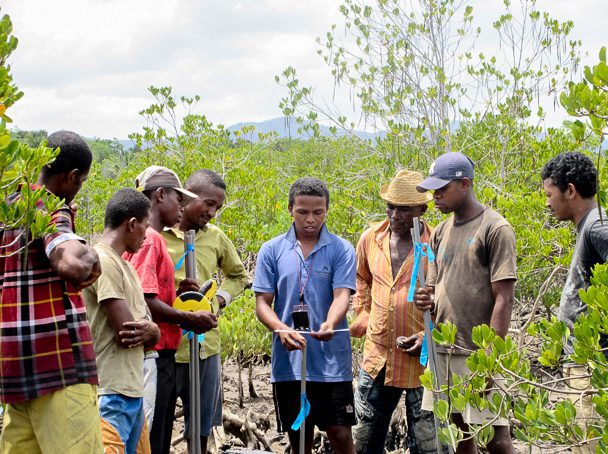This post is also available in:
 French
French
The members of my community are engaged in mangrove forest conservation and in a carbon offset project. Now they are seeing the benefits!”
Dany Ralaitianimaro, a fisher in southwest Madagascar, smiles: “The number of crabs and fish we catch every day is increasing again after having dropped a lot. And our childrens’ school fees and the cost of equipment will be covered by the sale of carbon credits.”
For coastal communities in Madagascar, mangroves are a source of wood for houses and cooking, a barrier against coastal erosion, storms and cyclones, and a haven for crabs, fish and shrimp, supporting small-scale fisheries.
But recently, along the country’s coastlines, fishing communities have also learned about mangroves’ well-kept secret: blue carbon. When preserved, these coastal forests between land and sea store up to five times more carbon per unit area than the Amazon rainforest. Mangroves are carbon sinks, and a crucial nature-based solution to climate breakdown.

Mangrove forests lie between land and sea | Photo: Garth Cripps
Monetising stored carbon into credits for carbon offsets provides funding for local mangrove management
For the remote communities who engage in sustainable mangrove management, often with little means, this is another reason to protect their ‘blue forests’. Monetising stored carbon into credits for carbon offsets provides funding for local mangrove management, like community patrols, as well as for much-needed community infrastructure and services: wells, clinics, schools and school fees for children. It is a win-win solution for both people and nature.
But to issue carbon credits, regular, accurate and verified data and measurements are required.
“Several years ago,” says Dany, “I noticed that the degradation of the mangroves directly translated into a decrease in the amount of fish I caught each day. So I started to take part in monitoring seagrass beds, reefs and finally mangroves. I wanted to better understand what was going on.” As a member of the community association that co-manages the Velondriake Marine Protected Area (MPA), Dany quickly got involved in collecting carbon data.
“Mangroves have an essential role in protecting our assets and our future,” adds Lido Djaomanjaka.
In Tsimipaika Bay, northwest Madagascar, Lido has been involved in all mangrove inventory activities since they were launched in 2013, which includes identification, monitoring and evaluation.
As a blue carbon scientist with Blue Ventures, I have demonstrated how to collect blue carbon data to members of Dany’s and Lido’s communities many times.
The process involves four key steps: firstly we select representative plots from thousands of hectares of mangrove forest based on GPS and mapping data; then, on each plot, we measure the diameter and height of the trees and the overhanging canopy (the part of the forest directly exposed to the sun) and collect soil samples; after this, we analyse the data and the samples in a laboratory in Antananarivo, Madagascar’s capital; and finally we integrate the main lessons of these analyses in our feedback to community associations and partners.
Then there is the reality of the field: long walks under the hot sun to reach a plot, with feet sinking into the mud with each step; the marking of the perimeter of the plot using sticks and ribbon and the installation of the measuring equipment; the fast and accurate measurements in a race against the tide – the mangrove plots become submerged in water at high tide, so the data collectors only have a few hours each day to carry out their work.
Before COVID-19, whenever it was time to carry out measurements on the plots, either my colleague Jaona or I would travel from Antananarivo to blue carbon sites around the country. We would pilot the scientific process with the Blue Ventures teams on site, accompanied by at least five members of the local community as guides and assistants. Some of them, like Dany and Lido, curious to learn more and motivated to repeat the experience despite the heat, the incessant mosquito bites and the gruelling pace, had become key members of the team. Through practice and training, they gradually learned the technical aspects of blue carbon monitoring.
“Today, community actions for the protection of mangroves are directly reflected in the increase of daily catches of crabs, fish and shrimps, and our coast is becoming more robust against erosion,” Lido says.In just a few years, Lido has become the most qualified community monitor in Tsimipaika Bay, while also engaging in a range of community initiatives. At 24 years old, he is now vice-president of the Ambolikapiky village association and a core member of the mangrove monitoring patrol. “Today, community actions for the protection of mangroves are directly reflected in the increase of daily catches of crabs, fish and shrimps, and our coast is becoming more robust against erosion,” Lido says.
Dany was selected to join the Velondriake Monitoring and Evaluation Committee, which represents his community in the monitoring and certification process of what has become the world’s largest community-based blue carbon project, Tahiry Honko, validated by the Plan Vivo standard in 2019.
Then COVID-19 came along and travel restrictions limited our support missions to the field; it was still imperative that data collection was carried out according to schedule. Whilst the transfer of skills to local communities and teams was already a mid to long term goal, the impacts of the pandemic mean that it has now become urgent.
In order for the data collectors to acquire the additional skills needed to take robust measurements autonomously, Jaona and I set up a training module.
When we were learning the theory, the technical words and names of the equipment were difficult to pronounce or to remember,” smiles Lido, “but we already knew some of them, like GPS or compass, which we use for fishing. And all the other words, we found code names for them in our dialect.”
The practical part, which we taught over five days, consisted of personal coaching. On the last day, Jaona and I didn’t say a word: provided with the material, equipment and coordinates of a plot, the data collectors had to find the plot and then do the installations and measurements without our support. We then checked the data using a statistical test: it was solid and consistent with what we would expect to see.
This year, while travel within Madagascar is still restricted due to COVID-19, the data collectors will be collecting blue carbon data in their respective mangrove forests autonomously. Jaona and I will do another statistical test, and we are confident about another accurate outcome. When we do the analysis of the samples in Antananarivo, it will be the culmination of the hard work of Dany, Lido and all of the other community blue carbon guardians.
Learn more about Blue Forests
Watch a short film about Tahiry Honko, the world’s largest community-led mangrove carbon conservation project
Read another blog by Ismaël Ratefinjanahary about blue carbon in Madagascar
This work has been supported by the UK government’s International Climate Finance (ICF) and the Global Environment Facility (GEF). The ICF refers to UK aid support given to poorer countries to help them deal with the causes of climate change, through actions such as protecting forests and mangroves, which act as vital carbon sinks, and restoring degraded ecosystems.



